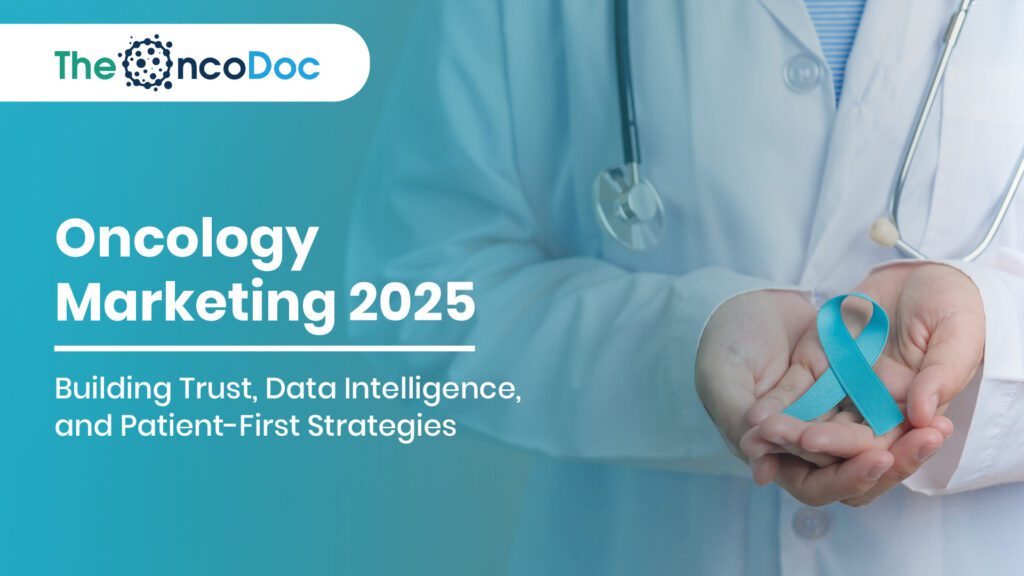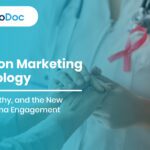Introduction: A New Blueprint for Oncology Marketing
Oncology marketing has entered a transformative era where success is measured not by how many prescriptions are generated but by how many lives are positively impacted. With precision medicine, immunotherapies, and AI-driven diagnostics evolving rapidly, the role of pharma marketers is shifting towards building ecosystems of education, awareness, and trust.
Cancer care today is more patient-driven and data-heavy than ever before. Patients, general practitioners (GPs), and oncologists rely on digital health tools, localized campaigns, and behavioral nudges to make informed decisions. Pharma companies that adopt empathetic, insight-driven, and hyper-personalized marketing are leading this change.
This article explores key trends, tactics, and technologies redefining oncology marketing in 2025, with detailed examples and strategic approaches.
1. The Rise of Patient-Centric Campaigns
Traditional pharma marketing focused primarily on doctors. But in oncology, patients and caregivers are equally critical decision-makers. Today, campaigns emphasize patient empowerment by:
- Providing educational content on early warning signs.
- Creating multilingual, easily digestible resources on treatment options.
- Sharing survivor-led video stories to reduce stigma and fear.
These efforts ensure that patients feel informed and supported before their first oncology consultation, building trust with the brand.
2. Data-Driven Segmentation of Oncology Markets
Oncology marketing is highly nuanced, as cancer patterns differ regionally. AI-driven data segmentation helps pharma companies create targeted strategies based on:
- Cancer type prevalence (e.g., breast cancer in urban India, oral cancers in rural areas).
- Digital behavior, like search trends for symptoms or screenings.
- Socioeconomic data, identifying barriers to early detection.
This approach enables highly localized campaigns that are more relevant and impactful for each specific audience group.
3. Engaging General Practitioners (GPs) for Early Referrals
GPs remain the first touchpoint for early cancer symptoms. Unfortunately, due to limited oncology training, many fail to refer patients for timely screenings.
Pharma companies are:
- Delivering WhatsApp-based CME (Continuing Medical Education) modules.
- Leveraging bite-sized learning tools such as quick videos and visual infographics.
- Creating referral toolkits that simplify diagnostic decision-making.
4. Omnichannel Marketing Strategies
The modern oncology marketer doesn’t rely on a single channel. Instead, omnichannel engagement ensures consistent messaging across:
- Social media (e.g., Instagram Reels with survivor stories).
- Mobile apps (offering screening reminders).
- Email campaigns (sharing oncology research updates).
- In-clinic touchpoints (interactive kiosks for patient education).
5. Behavioral Science in Oncology Campaigns
Behavioral insights help nudge patients towards positive actions. For instance:
- Automated reminders for mammogram screenings during Breast Cancer Awareness Month.
- Gamified symptom quizzes to encourage early consultations.
- Reward systems (like free screening vouchers) for attending diagnostic camps.
Such behavioral triggers can increase early screening participation by over 25%.
6. Emotional Storytelling with Survivor Voices
Cancer remains highly emotional and personal. Storytelling through real survivor narratives builds both empathy and credibility.
Survivor-led campaigns have been shown to:
- Drive 40% higher engagement rates than generic awareness ads.
- Build a trusted connection between pharma brands and communities.
- Motivate people to undergo preventive checkups.
7. AI-Powered Content Personalization
AI tools analyze individual health behaviors, browsing history, and past engagement to serve personalized cancer awareness content. For example:
- A 45-year-old woman who frequently searches “breast pain” could receive a tailored video about breast cancer self-exams.
- A smoker in Uttar Pradesh might get localized content on oral cancer screening camps.
8. Hyperlocal and Vernacular Campaigns
Cancer awareness is highly cultural. Campaigns succeed when they speak the language of the audience.
- In Tamil Nadu, localized Tamil-language breast cancer videos resonate better than English ads.
- In Assam, oral cancer awareness is delivered via folk performances and radio jingles.
Vernacular campaigns ensure higher comprehension and trust.
9. Building Digital Tools for Oncologists
Pharma brands are developing specialized dashboards and apps for oncologists that provide:
- AI-curated summaries of new cancer research.
- Patient tracking tools for treatment adherence.
- Peer-sharing platforms for oncologists to discuss rare cases.
This value-add approach transforms pharma brands into knowledge partners rather than mere suppliers.
10. Metrics that Reflect Real Impact
Vanity metrics like ad clicks are irrelevant in oncology. Instead, marketers focus on health-driven KPIs, such as:
- Number of screenings booked via campaigns.
- GP referral rates following educational drives.
- Engagement with symptom checker tools.
11. Collaborations with Key Opinion Leaders (KOLs)
Collaborating with local oncologists, trusted community physicians, or survivor advocates lends credibility to campaigns. These micro-influencers often have stronger grassroots connections than national figures, making them indispensable partners.
12. AI-Powered Predictive Campaigns
AI is becoming the backbone of oncology marketing. By analyzing search patterns, healthcare records, and social media chatter, AI predicts which regions or demographics are most likely to face a cancer-related surge.
Example:
- If AI detects a spike in searches for terms like “lump in neck” or “persistent cough” in a district, pharma brands can launch real-time micro-campaigns in that area.
- Predictive alerts also help GPs receive targeted educational content about relevant cancers in their region.
This data foresight transforms pharma marketing into a proactive health intervention tool rather than a reactive one.
13. Gamification and Digital Engagement Tools
Gamification is not just for fitness apps anymore. Oncology awareness campaigns are now using interactive elements to increase participation.
Key strategies include:
- Risk assessment quizzes where users receive a “health score” and tips to improve it.
- District-based challenges where communities compete in screening drives, with rewards for the highest participation.
- Achievement badges for completing screenings, shared on social media to motivate peers.
Gamification adds fun and curiosity to preventive care, improving screening turnout rates by up to 30%.
14. Wearables and Digital Health Integration
Smartwatches, fitness bands, and health trackers are now part of oncology prevention campaigns. Wearables can:
- Track vitals and lifestyle data (like weight loss or sleep patterns).
- Send personalized alerts if anomalies occur, nudging users towards early diagnostic tests.
- Integrate with pharma apps to provide tailored health content based on fitness data.
For instance, a sudden drop in BMI or abnormal heart rates could trigger an educational notification on cancer warning signs.
15. Partnerships with NGOs and Governments
Collaborations with public health authorities and NGOs amplify the reach of oncology campaigns.
- Pharma companies often co-sponsor free screening camps during national cancer awareness weeks.
- ASHA workers are trained with branded educational materials to reach rural populations.
- Joint efforts with state health ministries ensure that campaigns align with national cancer prevention goals.
Such collaborations add credibility and reduce operational costs.
16. Virtual Patient Communities
Digital communities are emerging as safe spaces for patients, survivors, and caregivers to connect. Pharma brands create and support these communities to:
- Host live webinars with oncologists.
- Provide emotional counseling sessions in local languages.
- Share success stories and coping strategies that inspire patients to pursue timely treatment.
These communities also serve as feedback channels, offering insights into patient pain points and misconceptions.
17. Voice Search & IVR Campaigns
With the rise of voice technology (Alexa, Google Assistant, IVR helplines), oncology awareness is becoming voice-first.
- Voice-based symptom checkers on WhatsApp can answer FAQs in local languages.
- IVR campaigns provide instant audio-based information for people with low literacy.
- Smart speakers are used in community centers for cancer awareness sessions.
This approach breaks literacy barriers and increases rural engagement.
18. Emotional Sentiment Analysis for Campaign Feedback
AI-powered sentiment analysis scans online comments, reviews, and feedback to gauge how audiences perceive a campaign.
- If a campaign triggers fear or confusion, the messaging can be tweaked to be more positive and reassuring.
- Survivor story content often performs better, as data shows audiences resonate more with empathy than statistics.
This ensures campaigns stay emotionally aligned with their audience.
19. Survivor Clubs for Community Outreach
Survivor clubs, sponsored by pharma brands, are becoming grassroots influencers.
- They host early detection workshops in schools and offices.
- Survivors share first-hand experiences of spotting symptoms early.
- Clubs collaborate with NGOs and hospitals to run localized awareness drives.
The peer-to-peer trust factor in these clubs makes awareness efforts more authentic and effective.
20. AR/VR in Oncologist Training
Cutting-edge AR (Augmented Reality) and VR (Virtual Reality) tools are revolutionizing oncology education for doctors.
- 3D simulations of tumor biology help oncologists understand how drugs work at the molecular level.
- VR platforms provide hands-on surgical training for rare cancer procedures.
- Pharma brands sponsor AR-based CME sessions, making them more interactive.
This blends learning with experience, ensuring oncologists are always ahead of the curve.
21. Smart Chatbots for Patient Triage
Chatbots are now virtual triage assistants that help:
- Guide patients with self-assessment questionnaires.
- Recommend nearby diagnostic centers.
- Provide step-by-step guidance on booking oncology consultations.
These chatbots, available on WhatsApp and web portals, operate 24/7-making them an essential part of patient engagement strategies.
22. Social Listening to Counter Myths
Cancer misinformation spreads fast. AI-powered social listening detects keywords and false narratives (e.g., “home remedies for cancer”) and triggers:
- Fact-check posts from trusted doctors.
- Awareness videos debunking common myths.
- Real-time alerts to marketing teams for rapid counter-campaigns.
23. Post-Treatment Engagement
Pharma brands now focus on holistic survivorship care:
- Offering rehabilitation apps that track post-treatment side effects.
- Providing nutritional plans tailored for recovery.
- Hosting emotional wellness programs, including stress management webinars.
This long-term engagement ensures survivors remain connected to the brand beyond treatment.
24. Future of Oncology Pharma Marketing
The future is predictive, personalized, and preventive. We’re moving towards:
- AI-driven symptom detection that flags potential risks even before patients realize them.
- Digital twins of patients, allowing tailored therapy simulations.
- Emotion-driven marketing, where campaigns focus as much on mental health and empowerment as on treatment.
The brands that combine data intelligence with human empathy will lead the next decade of oncology marketing.
Conclusion
Oncology marketing is no longer about product promotion-it’s about building awareness, trust, and actionable healthcare pathways. By combining AI-driven data insights, hyperlocal outreach, behavioral nudges, and survivor-led storytelling, pharma companies are reshaping how cancer is understood and managed.
The future belongs to those who measure success not by clicks, but by how many people detect cancer early, get timely treatment, and live longer, healthier lives.
The Oncodoc team is a group of passionate healthcare and marketing professionals dedicated to delivering accurate, engaging, and impactful content. With expertise across medical research, digital strategy, and clinical communication, the team focuses on empowering healthcare professionals and patients alike. Through evidence-based insights and innovative storytelling, Hidoc aims to bridge the gap between medicine and digital engagement, promoting wellness and informed decision-making.



